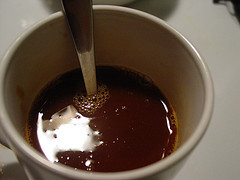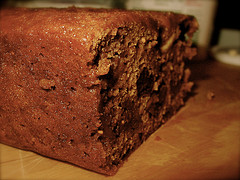A pound and quarter! Five sticks! Forty tablespoons! I defy you to use more in one recipe that isn’t
- a) buttercream wedding cake
- b) chocolate covered butter-stick
- c) written by Paula Deen


Sticky buns made from Brioche dough, recipe by Nancy Silverton from Baking with Julia. It’s not for the faint of heart but the hardest part is time management, and I’ll give you some tips. Even still, these aren’t practical to make more than a few times a year – and that will make your cardiologist happy anyway (3.4 oz butter per two-bun serving, eat three and that’s more than a stick of butter and a whole egg). Full parts list at the end.
Fear not the yeasties; fear not the chicken eggs nor the incorporation of three sticks of butter into your dough. But, my beemish boy, beware the lack of stand mixer. Trying this, or indeed any brioche dough, by hand is surely more frumious than any bandersnatch. Really. I did it by hand. Once. You must have a heavy duty stand mixer – Kitchen Aid classic or better – our 4.5qt Kitchen Aid gets really hot. Or do it by hand – maybe Amy Adams will play you in the movie.


Make some brioche dough:
The brioche dough recipe in the book is straightforward enough: make a sponge, knead in the rest of the flour and eggs then work in the butter. Totals are two and a half cups of flour, five eggs, a third of a cup each of milk and sugar. And a stick and a half of butter. (Are you counting?)
You mix up the sponge with part of the flour, cover it with the rest and set it aside. (1 c. flour, 1/3 c. warm whole milk, one egg and the yeast. Cover with another cup of flour and let work for 40 minutes.) When the sponge is good and bubbly, you add the rest of the dough ingredients, except for the butter. And this is where the heavy duty mixer comes in. Let it run for 15 minutes kneading the dough. (Mixer motor temperature: 100F.) Once you have a beautiful soft eggy dough, you proceed to gild the lilly – by adding the softened, but not melted, butter. Your nice dough will fall apart as the butter is added and the mixer is in for another workout doing the five to seven minutes of additional kneading required to get the butter incorporated. (Final mixer motor temperature about 110F.) Once it’s done it will all come back together and look really great – slightly satiny and soft. This is the prettiest dough I’ve come across. You’re looking for the fabled “slapping sound” from the dough hitting the mixer bowl.


Wait around for a good long time:
Let the dough rise for two hours or until doubled. Then you deflate it (“punch down” is a dumb term – never punch your dough, lift gently around the edges and press gently to redistribute the yeasties and their byproducts) and chill it during the second rise – 4 to 6 hours or overnight. I know; I did warn you it was elaborate.

The science here tells us that in addition to the kneading workout we gave it at the beginning to develop the gluten, this extended second rise will help create the distinctive crumb that makes brioche so wonderful. It also allows the butter a chance to rest and recover from any overheating.
Choose your path wisely:
After your dough has chilled, you have an decision to make: just how many sticky buns can you eat? With your blob of rested brioche dough, you can make two rolls of sticky buns or make one roll and some other sort of brioche-based yumminess, like a traditional tête or a more French Toast/Pain Perdu-friendly nanterre loaf. Complicating your decision is this: you can prepare two logs of sticky buns and freeze one for another time. This freezer trick is especially handy for blowing the minds of houseguests.
Sticky-bunify:

We’ll proceed to make the entire recipe of sticky buns – of course, use half quantities if you’re only making one roll of buns. Divide the rested dough in half, rewrap half and return it to the fridge. You need to keep the dough cool to avoid setting the yeast off or worse, melting the butter – the dough should never be greasy. Gently press and roll out the working half so you get a 11″ by 13″ rectangle. Spread half the butter (6 tablespoons) across the dough – you need to have the dough and the butter at cool room temperature for this to work reasonably well. Fold in thirds, like a business letter, then roll out to 11 x 13 (-ish) again, avoiding the edges (you’re making layers here). Fold in thirds again, then wrap tightly and refrigerate for at least half an hour.
Do it all again with the second half.
Mix the cinnamon and sugar and set aside. Beat the egg and grab your pasty brush. Take the first half out of the fridge after its rest and roll it out again. Paint it up with the egg – leave a bit at the top or bottom unpainted for sealing up the roll – and sprinkle half the cinnamon sugar over the dough. Spread half the chopped nuts and press them gently into the dough so they stick. Roll tightly and wrap, seam side down, in plastic.
Chill:
Freeze long enough to harden lightly, about 45 minutes. Do the same fill-and-roll routine for the second piece of dough.
This is the part where you can double-wrap one of your rolls and leave it in the freezer for another time. Just let it defrost, wrapped, on the counter for 15 or 20 minutes before proceeding.
More butter, please:
Prep your pan(s) for the rolls – you’re actually making the sticky topping in the bottom of the pan.You need one 9″ round cake pan with “high sides” per roll – I find my 3″ deep pan works great, but I have done it in the supermarket 1.5″ cake pan with just OK results. Press a stick of butter into the bottom of the pan then cover evenly with half a cup of brown sugar.
With the roll(s) that have been in the freezer for just under an hour, proceed by pulling it out and pressing firmly to make sure it’s truly round. Measure out (yes, get a ruler) seven even slices – about 1.5 inches and slice them off. I use a serrated knife to avoid mashing the roll. You’ll need to reshape them gently into rounds. Press three pecan halves into the top of each bun – I like to make a little triangle – them flip them, pecan-side-down into the prepared pan. Put 6 around the outside – seams out – and the last one in the center. Repeat with the second log if you’re doing two. Let the prepared rolls proof for two hours or so, until the slices are touching each other. Bake in at 350F oven 35 to 40 minutes. If you’re using a shorter cake pan, put foil or a sheet pan on a lower rack to catch drips.


Avoid the molten sugar and eat up!
Remove from oven, let cool for just five minutes – then invert onto a serving platter. Be careful as you’re flopping around molten caramel, and likely some melty, drippy butter. Remove the cake pan and let the buns cool for several minutes on the platter to avoid sugar burns. Serve warm, and really, you need to eat them all the first day. They don’t keep too well.
Timeline suggestions
Well. It’s going to take a while no matter what. I like to make the dough in the morning, get through the first rise and get it in the fridge before lunch or errands or whatever. Then in the evening, before bed, you can knock out the butter and turns, and fill and roll and into the freezer. That’s about an hour’s active work with the half-hour rest after the butter-and-turns.The day you want to eat them, you can get up really early and defrost, pan, proof and bake, but that makes for a really early day, even for a brunch-time breakfast. I’ve been known to cheat and slice and pan them the night before, cover and refrigerate. Then set an alarm for early, take them out of the fridge and let them proof while you have a little nap. Then bake them off and you can have them at actual breakfast time.
Parts list, brioche dough:
- 3 1/2 c. all purpose flour
- 2 1/4 tsp. active dry yeast (or one packet)
- 5 large eggs
- 1/3 c. whole milk
- 1/3 c. sugar
- 1 tsp kosher salt or 1/2 tsp. table salt
- 1.5 sticks (6 oz.) unsalted butter
Parts list, sticky buns (makes two logs, 14 buns):
- 3.5 sticks unsalted butter
- 1/4 c. sugar
- 1/4 tsp. cinnamon
- 1 large egg
- 1 c. chopped pecans
- 1 c. packed brown sugar
- 42 pecan halves – about a cup and a half
Tools:
- Heavy duty stand mixer
- Serrated knife
- Pastry brush
- 9″ round x 3″ deep cake pan
- Serving platter bigger than your cake pan (safety first!)




